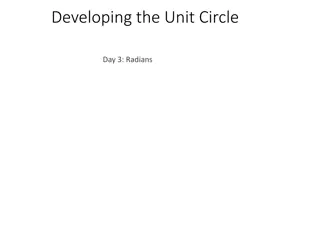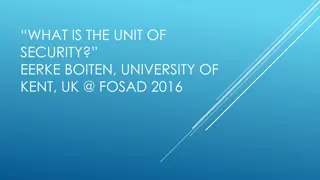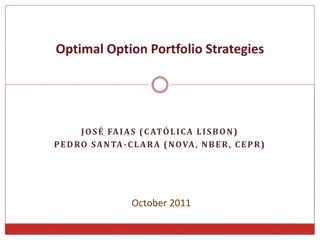
Virtual Functions and Polymorphism in C++
Explore the concept of virtual functions and polymorphism in C++, how they enable run-time polymorphism, and how derived classes redefine virtual functions to suit their own needs. Learn how to implement and utilize virtual functions through code examples.
Download Presentation

Please find below an Image/Link to download the presentation.
The content on the website is provided AS IS for your information and personal use only. It may not be sold, licensed, or shared on other websites without obtaining consent from the author. If you encounter any issues during the download, it is possible that the publisher has removed the file from their server.
You are allowed to download the files provided on this website for personal or commercial use, subject to the condition that they are used lawfully. All files are the property of their respective owners.
The content on the website is provided AS IS for your information and personal use only. It may not be sold, licensed, or shared on other websites without obtaining consent from the author.
E N D
Presentation Transcript
Subject Name: Object Oriented Programming With C++ Subject Code: 10CS36 Prepared By: Deepa, Madhuleena Das, Tamilarasi, Neema Babu Department: CSE Date:10/10/2014 4/3/2025 4/3/2025
Virtual Functions and Polymorphism 4/3/2025 4/3/2025
Virtual Function A virtual function is a member function that is declared within a base class and redefined by a derived class. To create a virtual function, precede the function's declaration in the base class with the keyword virtual. When a class containing a virtual function is inherited, the derived class redefines the virtual function to fit its own needs. 4/3/2025
When accessed "normally," virtual functions behave just like any other type of class member function. But they support run-time polymorphism. A base-class pointer can be used to point to an object of any class derived from that base. When a base pointer points to a derived object that contains a virtual function, C++ determines which version of that function to call based upon the type of object pointed to by the pointer. And this determination is made at run time. Thus, when different objects are pointed to, different versions of the virtual function are executed. 4/3/2025
#include <iostream> using namespace std; class base { public: virtual void vfunc() { cout << "This is base's vfunc().\n"; } }; class derived1 : public base { public: void vfunc() { cout << "This is derived1's vfunc().\n"; } }; class derived2 : public base { public: void vfunc() { cout << "This is derived2's vfunc().\n"; } 4/3/2025 };
int main() { base *p, b; derived1 d1; derived2 d2; // point to base p = &b; p->vfunc(); // access base's vfunc() // point to derived1 p = &d1; p->vfunc(); // access derived1's vfunc() // point to derived2 p = &d2; p->vfunc(); // access derived2's vfunc() return 0; } OUTPUT This program displays the following: This is base's vfunc(). This is derived1's vfunc(). This is derived2's vfunc(). 4/3/2025
In this program, base is inherited by both derived1 and derived2. Inside each class definition, vfunc( ) is redefined relative to that class. Inside main( ), four variables are declared: Name Type p base class pointer b object of base d1 object of derived1 d2 object of derived2 4/3/2025
Next, p is assigned the address of b, and vfunc( ) is called via p. Since p is pointing to an object of type base, that version of vfunc( ) is executed. Next, p is set to the address of d1, and again vfunc( ) is called by using p. This time p points to an object of type derived1. This causes derived1::vfunc( ) to be executed. Finally, p is assigned the address of d2, and p >vfunc( ) causes the version of vfunc( ) redefined inside derived2 to be executed. The key point here is that the kind of object to which p points determines which version of vfunc( ) is executed. Further, this determination is made at run time, and this process forms the basis for run-time polymorphism. The preceding example is also syntactically valid: d2.vfunc(); // calls derived2's vfunc() Although calling a virtual function in this manner is not wrong 4/3/2025
Difference between overloading and Virtual functions The most important difference is that the prototype for a redefined virtual function must match exactly the prototype specified in the base class. This differs from overloading a normal function, in which return types and the number and type of parameters may differ. when a virtual function is redefined, all aspects of its prototype must be the same. If we change the prototype when we attempt to redefine a virtual function, the function will simply be considered overloaded by the C++ compiler, and its virtual nature will be lost. 4/3/2025
Another important restriction is that virtual functions must be nonstatic members of the classes of which they are part. They cannot be friends. Finally, constructor functions cannot be virtual, but destructor functions can. Because of the restrictions and differences between function overloading and virtual function redefinition, the term overriding is used to describe virtual function redefinition by a derived class. 4/3/2025
Calling a Virtual Function Through a Base Class Reference The polymorphic nature of a virtual function is also available when called through a base-class reference. A reference is an implicit pointer. Thus, a base-class reference can be used to refer to an object of the base class or any object derived from that base. When a virtual function is called through a base-class reference, the version of the function executed is determined by the object being referred to at the time of the call. The most common situation in which a virtual function is invoked through a base class reference is when the reference is a function parameter. 4/3/2025
/* Here, a base class reference is used to access a virtual function. */ #include <iostream> using namespace std; class base { public: virtual void vfunc() { cout << "This is base's vfunc().\n"; } }; class derived1 : public base { public: void vfunc() { cout << "This is derived1's vfunc().\n"; } }; class derived2 : public base { public: void vfunc() { cout << "This is derived2's vfunc().\n"; 4/3/2025 } };
// Use a base class reference parameter. void f(base &r) { r.vfunc(); } int main() { base b; derived1 d1; derived2 d2; f(b); // pass a base object to f() f(d1); // pass a derived1 object to f() f(d2); // pass a derived2 object to f() return 0; } This program produces the same output as its preceding version. In this example, the function f( ) defines a reference parameter of type base. Inside main( ), the function is called using objects of type base, derived1, and derived2. Inside f( ), the specific version of vfunc( ) that is called is determined by the type of object being referenced when the function is called. 4/3/2025
The Virtual Attribute Is Inherited When a virtual function is inherited, its virtual nature is also inherited. This means that when a derived class that has inherited a virtual function is itself used as a base class for another derived class, the virtual function can still be overridden. No matter how many times a virtual function is inherited, it remains virtual. 4/3/2025
#include <iostream> using namespace std; class base { public: virtual void vfunc() { cout << "This is base's vfunc().\n"; } }; class derived1 : public base { public: void vfunc() { cout << "This is derived1's vfunc().\n"; } }; /* derived2 inherits virtual function vfunc() from derived1. */ class derived2 : public derived1 { public: // vfunc() is still virtual void vfunc() { cout << "This is derived2's vfunc().\n"; } }; 4/3/2025
int main() { base *p, b; derived1 d1; derived2 d2; // point to base p = &b; p->vfunc(); // access base's vfunc() // point to derived1 p = &d1; p->vfunc(); // access derived1's vfunc() // point to derived2 p = &d2; p->vfunc(); // access derived2's vfunc() return 0; } As expected, the preceding program displays this output: This is base's vfunc(). This is derived1's vfunc(). This is derived2's vfunc(). In this case, derived2 inherits derived1 rather than base, but vfunc( ) is still virtual. 4/3/2025
Virtual Functions Are Hierarchical when a function is declared as virtual by a base class, it may be overridden by a derived class. However, the function does not have to be overridden. When a derived class fails to override a virtual function, then when an object of that derived class accesses that function, the function defined by the base class is used. 4/3/2025
#include <iostream> using namespace std; class base { public: virtual void vfunc() { cout << "This is base's vfunc().\n"; } }; class derived1 : public base { public: void vfunc() { cout << "This is derived1's vfunc().\n"; } }; class derived2 : public base { public: // vfunc() not overridden by derived2, base's is used }; 4/3/2025
int main() { base *p, b; derived1 d1; derived2 d2; // point to base p = &b; p->vfunc(); // access base's vfunc() // point to derived1 p = &d1; p->vfunc(); // access derived1's vfunc() // point to derived2 p = &d2; p->vfunc(); // use base's vfunc() return 0; } The program produces this output: This is base's vfunc(). This is derived1's vfunc(). 4/3/2025 This is base's vfunc().
Because derived2 does not override vfunc( ), the function defined by base is used when vfunc( ) is referenced relative to objects of type derived2. Because inheritance is hierarchical in C++, it makes sense that virtual functions are also hierarchical. This means that when a derived class fails to override a virtual function, the first redefinition found in reverse order of derivation is used. For example, in the following program, derived2 is derived from derived1, which is derived from base. However, derived2 does not override vfunc( ). This means that, relative to derived2, 4/3/2025
#include <iostream> using namespace std; class base { public: virtual void vfunc() { cout << "This is base's vfunc().\n"; } }; class derived1 : public base { public: void vfunc() { cout << "This is derived1's vfunc().\n"; } }; class derived2 : public derived1 { public: /* vfunc() not overridden by derived2. In this case, since derived2 is derived from derived1, derived1's vfunc() is used. */ 4/3/2025 };
int main() { base *p, b; derived1 d1; derived2 d2; // point to base p = &b; p->vfunc(); // access base's vfunc() // point to derived1 p = &d1; p->vfunc(); // access derived1's vfunc() // point to derived2 p = &d2; p->vfunc(); // use derived1's vfunc() return 0; } OUTPUT The program displays the following: This is base's vfunc(). 4/3/2025 This is derived1's vfunc(). This is derived1's vfunc().
PURE VIRTUAL FUNCTIONS A pure virtual function is a virtual function that has no definition within the base class. To declare a pure virtual function, use this general form: virtual type func-name(parameter-list) = 0; When a virtual function is made pure, any derived class must provide its own definition. If the derived class fails to override the pure virtual function, a compile-time error will result. 4/3/2025
#include <iostream> using namespace std; class number { protected: int val; public: void setval(int i) { val = i; } // show() is a pure virtual function virtual void show() = 0; }; class hextype : public number { public: void show() { cout << hex << val << "\n"; } }; 4/3/2025
class dectype : public number { public: void show() { cout << val << "\n"; } }; class octtype : public number { public: void show() { cout << oct << val << "\n"; } }; 4/3/2025
int main() { dectype d; hextype h; octtype o; d.setval(20); d.show(); // displays 20 - decimal h.setval(20); h.show(); // displays 14 hexadecimal o.setval(20); o.show(); // displays 24 - octal return 0; } 4/3/2025
Abstract Classes A class that contains at least one pure virtual function is said to be abstract. Because an abstract class contains one or more functions for which there is no definition (that is, a pure virtual function), no objects of an abstract class may be created. Instead, an abstract class constitutes an incomplete type that is used as a foundation for derived classes. Although we cannot create objects of an abstract class, we can create pointers and references to an abstract class. This allows abstract classes to support run-time polymorphism, which relies upon base-class pointers and references to select the proper virtual function. 4/3/2025
Using Virtual Functions One of the most powerful and flexible ways to implement the "one interface, multiple methods" approach is to use virtual functions, abstract classes, and run-time polymorphism. Using these features, we create a class hierarchy that moves from base to derived. Following this philosophy, we define all common features and interfaces in a base class. In cases where certain actions can be implemented only by the derived class, use a virtual function. In essence, in the base class create and define everything that can be related to the general case. The derived class fills in the specific details. 4/3/2025
// Virtual function practical example. #include <iostream> using namespace std; class convert { protected: double val1; // initial value double val2; // converted value public: convert(double i) { val1 = i; } double getconv() { return val2; } double getinit() { return val1; } virtual void compute() = 0; }; 4/3/2025
// Liters to gallons. class l_to_g : public convert { public: l_to_g(double i) : convert(i) { } void compute() { val2 = val1 / 3.7854; } }; // Fahrenheit to Celsius class f_to_c : public convert { public: f_to_c(double i) : convert(i) { } void compute() { val2 = (val1-32) / 1.8; } }; 4/3/2025
int main() { convert *p; // pointer to base class l_to_g lgob(4); f_to_c fcob(70); // use virtual function mechanism to convert p = &lgob; cout << p->getinit() << " liters is "; p->compute(); cout << p->getconv() << " gallons\n"; // l_to_g p = &fcob; cout << p->getinit() << " in Fahrenheit is "; p->compute(); cout << p->getconv() << " Celsius\n"; // f_to_c return 0; } 4/3/2025
One of the benefits of derived classes and virtual functions is that handling a new case is a very easy matter. For example, assuming the preceding program, you can add a conversion from feet to meters by including this class: // Feet to meters class f_to_m : public convert { public: f_to_m(double i) : convert(i) { } void compute() { val2 = val1 / 3.28; } }; 4/3/2025
Early vs. Late Binding Early binding refers to events that occur at compile time. Early binding occurs when all information needed to call a function is known at compile time. Early binding means that an object and a function call are bound during compilation. Examples of early binding include normal function calls (including standard library functions), overloaded function calls, and overloaded operators. The main advantage to early binding is efficiency. Because all information necessary to call a function is determined at compile time, these types of function calls are very fast. 4/3/2025
Late binding refers to function calls that are not resolved until run time. Virtual functions are used to achieve late binding. When access is via a base pointer or reference, the virtual function actually called is determined by the type of object pointed to by the pointer. Because in most cases this cannot be determined at compile time, the object and the function are not linked until run time. 4/3/2025
The main advantage to late binding is flexibility Unlike early binding, late binding allows you to create programs that can respond to events occurring while the program executes without having to create a large amount of code. Keep in mind that because a function call is not resolved until run time, late binding can make for somewhat slower execution times. 4/3/2025






















